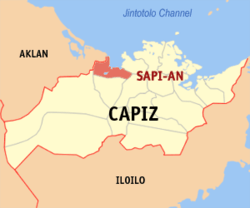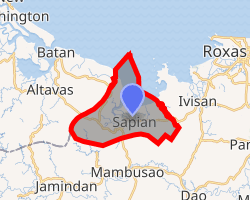Sapian
Sapian, officially the Municipality of Sapian (Capiznon/Hiligaynon: Banwa sang Sapian; Aklanon: Banwa it Sapian; Tagalog: Bayan ng Sapian), and sometimes spelled Sapi-an, is a 4th class municipality in the province of Capiz, Philippines. According to the 2015 census, it has a population of 25,821 people.[3] It is 27 kilometres (17 mi) from Roxas City, the provincial capital.
Sapian | |
|---|---|
| Municipality of Sapian | |
 Map of Capiz with Sapian highlighted | |
OpenStreetMap 
| |
.svg.png) Sapian Location within the Philippines | |
| Coordinates: 11°30′N 122°36′E | |
| Country | |
| Region | Western Visayas (Region VI) |
| Province | Capiz |
| District | 2nd district of Capiz |
| Barangays | 10 (see Barangays) |
| Government | |
| • Type | Sangguniang Bayan |
| • Mayor | Arthur John H. Biñas |
| • Vice Mayor | Ralph C. Odrunia |
| • Congressman | Fredenil H. Castro |
| • Electorate | 18,903 voters (2019) |
| Area | |
| • Total | 105.24 km2 (40.63 sq mi) |
| Population (2015 census)[3] | |
| • Total | 25,821 |
| • Density | 250/km2 (640/sq mi) |
| • Households | 6,106 |
| Economy | |
| • Income class | 4th municipal income class |
| • Poverty incidence | 21.1% (2015)[4] |
| • Revenue (₱) | 73,756,789.52 (2016) |
| Time zone | UTC+8 (PST) |
| ZIP code | 5806 |
| PSGC | |
| IDD : area code | +63 (0)36 |
| Climate type | tropical climate |
| Native languages | Capiznon Hiligaynon Tagalog |
| Website | www |
Sapian Bay which is situated in the northern part of the municipality is geographically joined with Capiz Bay. The 30 km² Sapian and Capiz shallow sea bays has extensive intertidal mudflats, sandy beaches, mangrove swamps, estuaries of several small rivers, and associated coastal lagoons and marshes. Sapian Bay which opens up to the Sibuyan Sea is a source of livelihood for many Sapianons. Marine produce from Sapian Bay include green mussels "tahong", oyster "talaba", lobster and different species of fish,and clams. Many lands near sea water were developed into fishponds that produce milkfish (bangus), prawns and crabs.
Another source of livelihood is agriculture. Carpets of rice fields, trees and flowers can be seen as one travels through Sapian along the national road which connect Roxas City to Iloilo and Aklan. The ricefield along the national road are slowly disappearing to give way to housing developments. Sapian's main agricultural produce are rice and coconuts.
Barangays
Sapian is politically subdivided into 10 barangays. [2]
- Agsilab
- Agtatacay Norte
- Agtatacay Sur
- Bilao
- Damayan
- Dapdapan
- Lonoy
- Majanlud
- Maninang
- Poblacion
Climate
| Climate data for Sapian, Capiz | |||||||||||||
|---|---|---|---|---|---|---|---|---|---|---|---|---|---|
| Month | Jan | Feb | Mar | Apr | May | Jun | Jul | Aug | Sep | Oct | Nov | Dec | Year |
| Average high °C (°F) | 27 (81) |
28 (82) |
29 (84) |
31 (88) |
32 (90) |
31 (88) |
30 (86) |
30 (86) |
29 (84) |
29 (84) |
29 (84) |
27 (81) |
29 (85) |
| Average low °C (°F) | 23 (73) |
23 (73) |
23 (73) |
24 (75) |
25 (77) |
25 (77) |
24 (75) |
24 (75) |
24 (75) |
24 (75) |
24 (75) |
23 (73) |
24 (75) |
| Average precipitation mm (inches) | 61 (2.4) |
39 (1.5) |
46 (1.8) |
48 (1.9) |
90 (3.5) |
144 (5.7) |
152 (6.0) |
145 (5.7) |
163 (6.4) |
160 (6.3) |
120 (4.7) |
90 (3.5) |
1,258 (49.4) |
| Average rainy days | 12.3 | 9.0 | 9.9 | 10.0 | 18.5 | 25.0 | 27.4 | 26.0 | 25.9 | 24.9 | 17.9 | 14.2 | 221 |
| Source: Meteoblue [5] | |||||||||||||
Demographics
| Year | Pop. | ±% p.a. |
|---|---|---|
| 1903 | 3,185 | — |
| 1918 | 4,398 | +2.17% |
| 1939 | 7,391 | +2.50% |
| 1948 | 8,218 | +1.19% |
| 1960 | 11,638 | +2.94% |
| 1970 | 14,171 | +1.99% |
| 1975 | 17,395 | +4.20% |
| 1980 | 18,753 | +1.51% |
| 1990 | 22,011 | +1.62% |
| 1995 | 22,534 | +0.44% |
| 2000 | 22,912 | +0.36% |
| 2007 | 23,552 | +0.38% |
| 2015 | 25,821 | +1.16% |
| Source: Philippine Statistics Authority[3][6][7][8] | ||
In the 2015 census, the population of Sapian was 25,821 people,[3] with a density of 250 inhabitants per square kilometre or 650 inhabitants per square mile.
Languages
Capiznon and Hiligaynon are the main languages of Sapian, but Aklanon is also spoken and understood due to its proximity to Aklan.
The town center
In the center of town (or poblacion) is a well-maintained park known simply as the plaza. It is the venue of many celebrations especially during the town fiesta. The people of Sapian show lavish cultural and religious celebrations from July 22 to 26 each year in honour of their patron saint Santa Ana.
Few meters away from the plaza is the municipal hall which holds local government offices. Next to it is the barangay hall and health clinic. Nearby is Sapian Elementary School, two big churches, the Catholic Church and the Aglipayan Church, and the public market.
About one kilometre from the town center is Sapian National High School and Capiz State University (CAPSU) Sapian Campus.
References
- "Municipality". Quezon City, Philippines: Department of the Interior and Local Government. Retrieved 31 May 2013.
- "Province: Capiz". PSGC Interactive. Quezon City, Philippines: Philippine Statistics Authority. Retrieved 12 November 2016.
- Census of Population (2015). "Region VI (Western Visayas)". Total Population by Province, City, Municipality and Barangay. PSA. Retrieved 20 June 2016.
- "PSA releases the 2015 Municipal and City Level Poverty Estimates". Quezon City, Philippines. Retrieved 12 October 2019.
- "Sapian: Average Temperatures and Rainfall". Meteoblue. Retrieved 2 May 2020.
- Census of Population and Housing (2010). "Region VI (Western Visayas)". Total Population by Province, City, Municipality and Barangay. NSO. Retrieved 29 June 2016.
- Censuses of Population (1903–2007). "Region VI (Western Visayas)". Table 1. Population Enumerated in Various Censuses by Province/Highly Urbanized City: 1903 to 2007. NSO.
- "Province of Capiz". Municipality Population Data. Local Water Utilities Administration Research Division. Retrieved 17 December 2016.